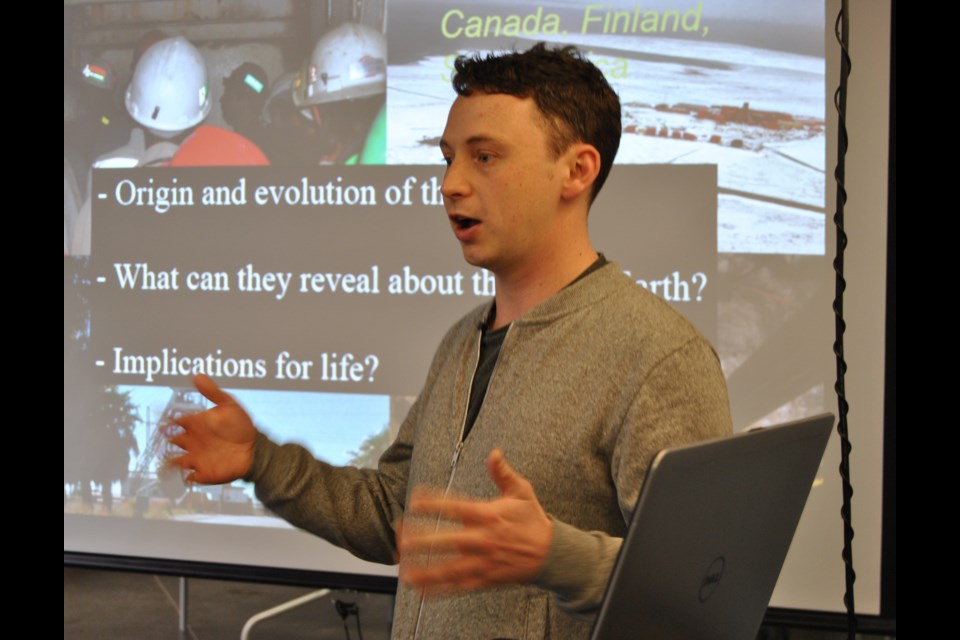Scientists from the University of Toronto presented their research to an audience at Northern College into what is believed to be the world's oldest water discovered at the deepest levels of Kidd Creek Mine and at locations in South Africa and Finland.
The team consisting of Oliver Warr, Chris Charles, Allyson Brady and Thomas Giunta from the University of Toronto and Allyson from McMaster University will be in Timmins this week to continue researching and sampling at Kidd Creek Mine at even deeper levels than before.
"It's a fantastic opportunity to come up here and present the research we've been able to do and the collaboration we have been able to foster as a result of our working in the City of Timmins,” said Oliver Warr, a post doctoral researcher at the University of Toronto.
"We are here to follow up on work we completed in July, 2016 when we sampled and set up filters at the 7,800 ft. level," explained team leader Oliver Warr. "We are going to again sample at the 7,800 foot level, but in addition we are going to descend another 2,000 feet and sample at the 9,500 feet level."
Warr explained that the research is a continuation of the project that was initiated by the Barbara Sherwood Lollar in 1982 which has collected samples at Coppercliffe in Sudbury; Matagami, Quebec; Thompson, Manitoba and Northwest Territories
In 1992 Sherwood Lollar first conducted research at the 5,800 ft level at Kidd Creek and followed up with testing in 2012, 2013 and 2016.
“We have been sampling to address three key questions,” explained Warr. “First, where did these fluids come from and since these rocks are some of he oldest rocks in the world is the water the same age as them, did the water come in later?"
"Second, if they are as old as the rocks, what might that be able to reveal about the early earth?” asked Warr.
“And third, do they host life and if they do host life, as they have been isolated over significant geological time periods, what might this life be able to reveal about early life, the evolution of life and the potential of habitability of life on earth and also on other planets,” he said.
In addition, research in Canada, the U of T team has been conducted in Finland and in South Africa. Most of the microbial studies to date have been from sites in Witwatersrand Basin SA, the deepest microbial ecosystem to date at 2.8 km.
Northern College will be where the team stores their water samples, rock samples and other samples germane to their research including potentially ancient life forms.
“Northern College will serve as their lab while the researchers are here and we will also be providing the team with staff assistance to collect samples, and as this project matures we hope to find a more expansive role for the college,” said Fred Gibbons, President of Northern College.
“Northern has been involved in the applied research field for about five years and this catapults us to research of global interest,” Gibbons added.
The project has made significant scientific discoveries since 1992 when Dr. Sherwood Lollar first researched at Kidd Creek.
“With, the cooperation of Kidd Creek mine we were able to gain accesses to 5,800 ft. in 1992 which at the time was the bottom of the mine,” said Warr.
Sherwood Lollar’s research and research by other members of her team has been published in scientific journals such as Nature and Science
This was followed up with work in 2013 which led to it being named the top scientific story of 2013 when they discovered billion-year-old water.
"Perhaps the most well known was the study of 2013, at level 7850, which was one of the deepest accessible parts of the mine at the time, and the fluids we found were measured for their noble gas contents,” Warr stated.
“The noble gases accumulated over time in these fluids were the radioactive decay from radioactive substances such as uranium, radium, thorium,” explained Warr. “They can be used as a sort of chronometer to work out how long these fluids have been isolated from the modern hydro-geosphere.”
After conducting their research at Kidd Creek, the U of T researchers plan to hold strategic workshops later this year to identify other questions in need of answering
“We've got some great research happening, but we have by no means gotten to the bottom of the barrel,” said Warr.
"An even larger workshop will follow to address what future samples may be required and what funding can be obtained."
The U of T research has garnered about 300 international media stories to date including coverage from National Geographic, National Public Radio, Scientific American, the Huffington Post, the BBC, CBC Quirks and Quarks, CNN, Fox News, the Toronto Star, Globe and Mail and even the Tonight Show.
It has been written about in the British, German, French and even South American press
Universities that partnered with U of T include: Oxford, McMaster, Caltech, Princeton, University of Bremen, UCLA and University of Alberta
Universities who expressed interest for upcoming visits include: UBC, Michigan State, McGill, Yale, New Mexico Tech, Desert Research Institute, Tokyo Tech and University of Manchester.
Partnerships have also been established with International groups NASA, the Astrobiology Institute, SURF Lab and SNOLab.



